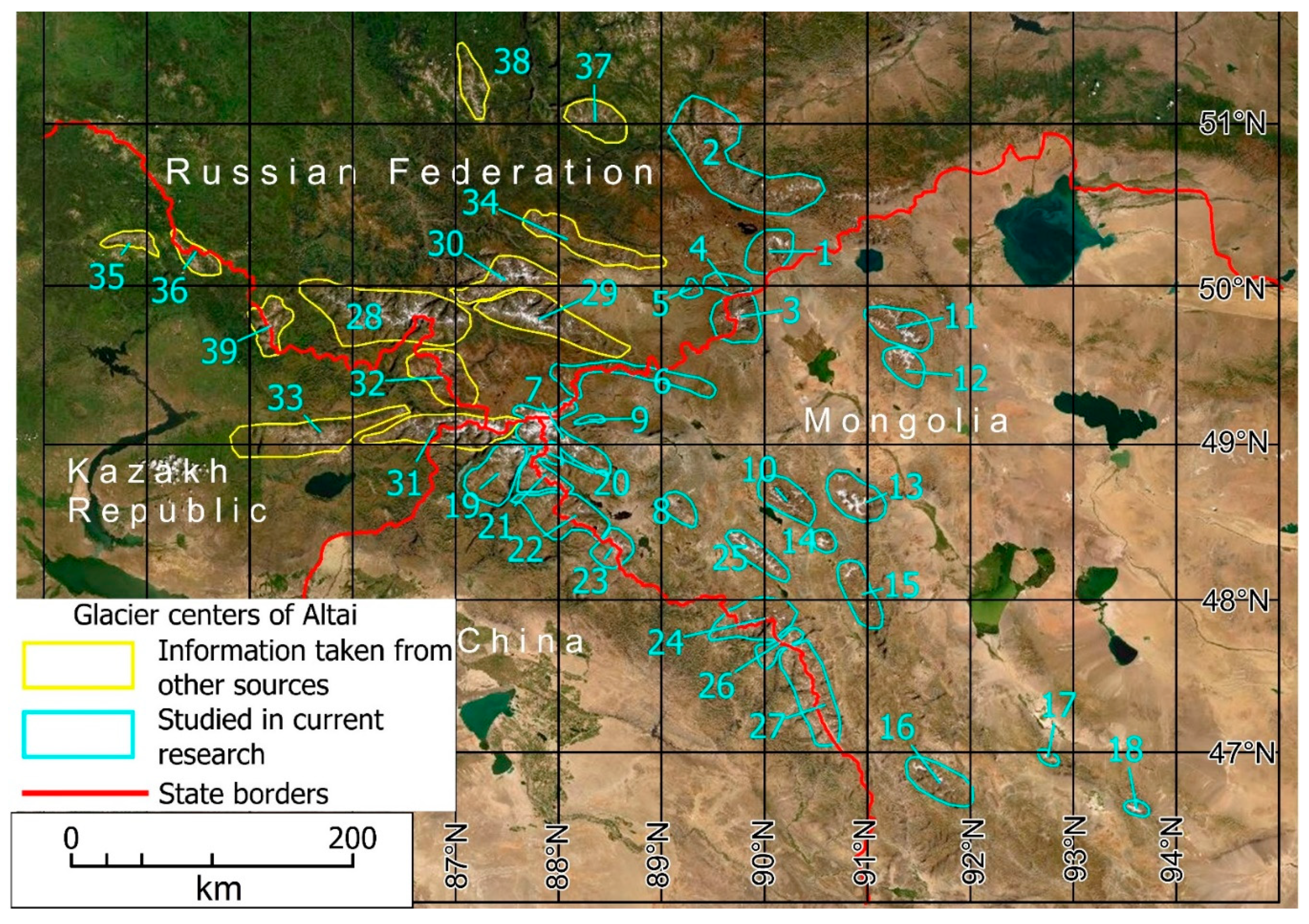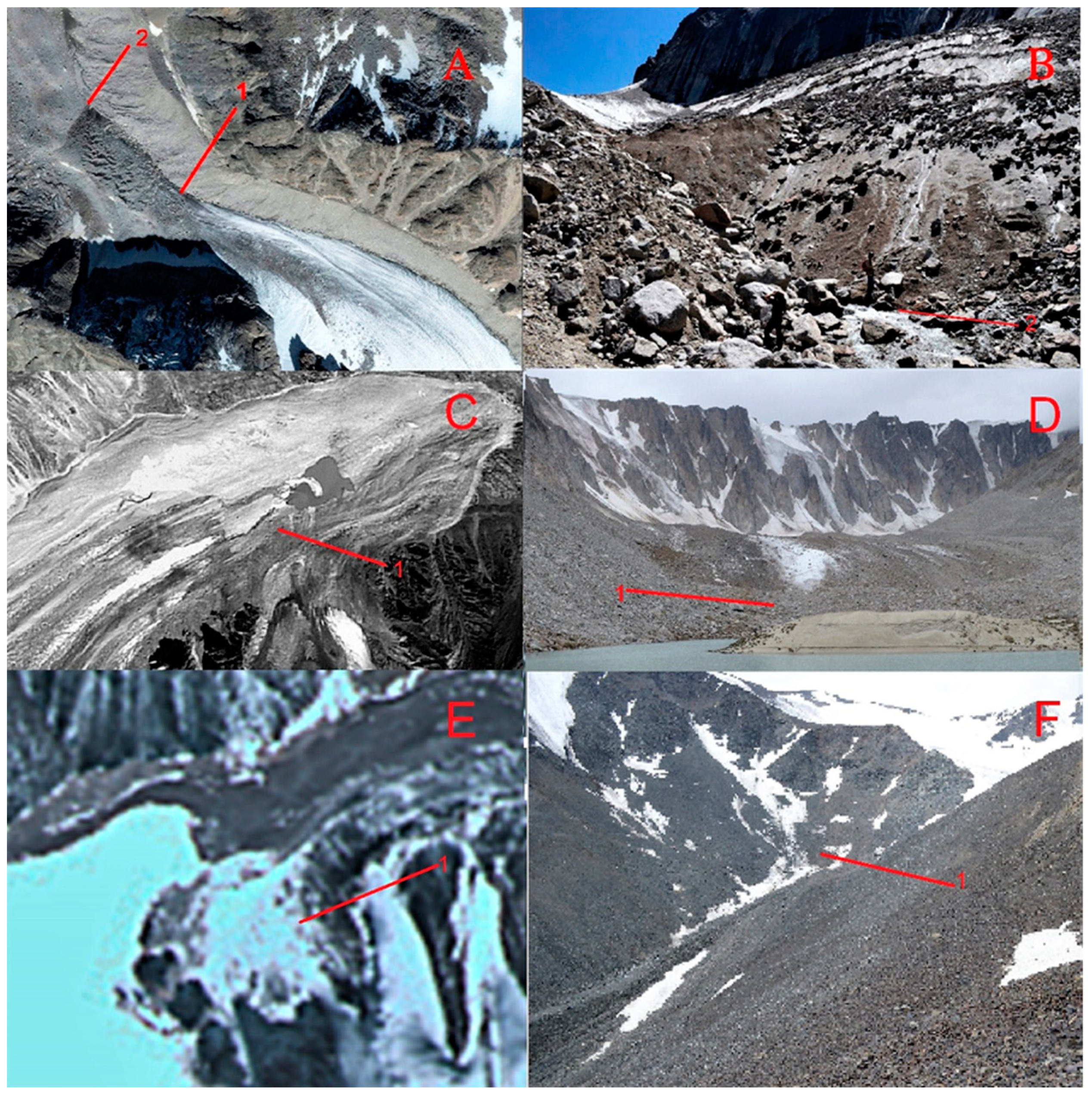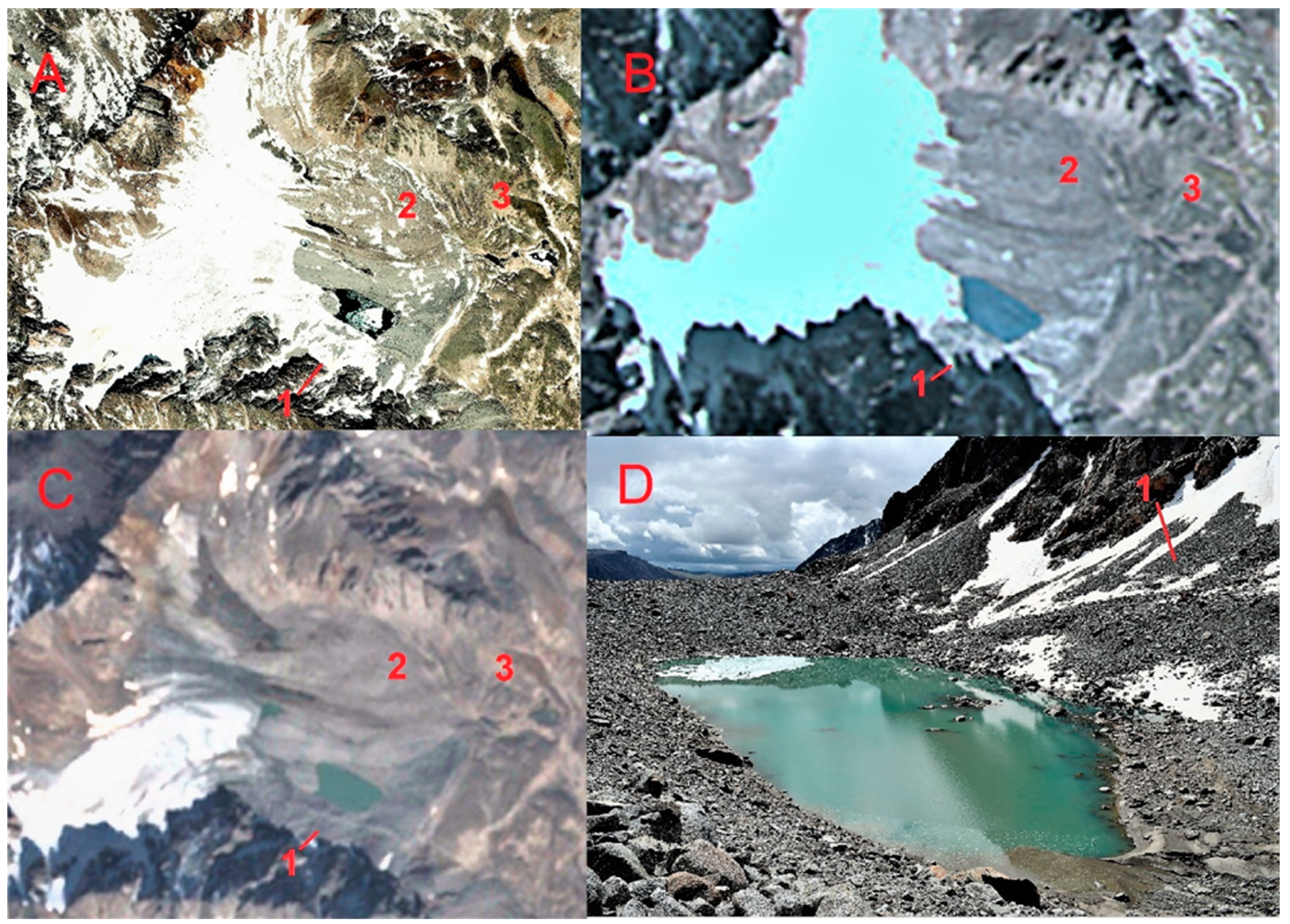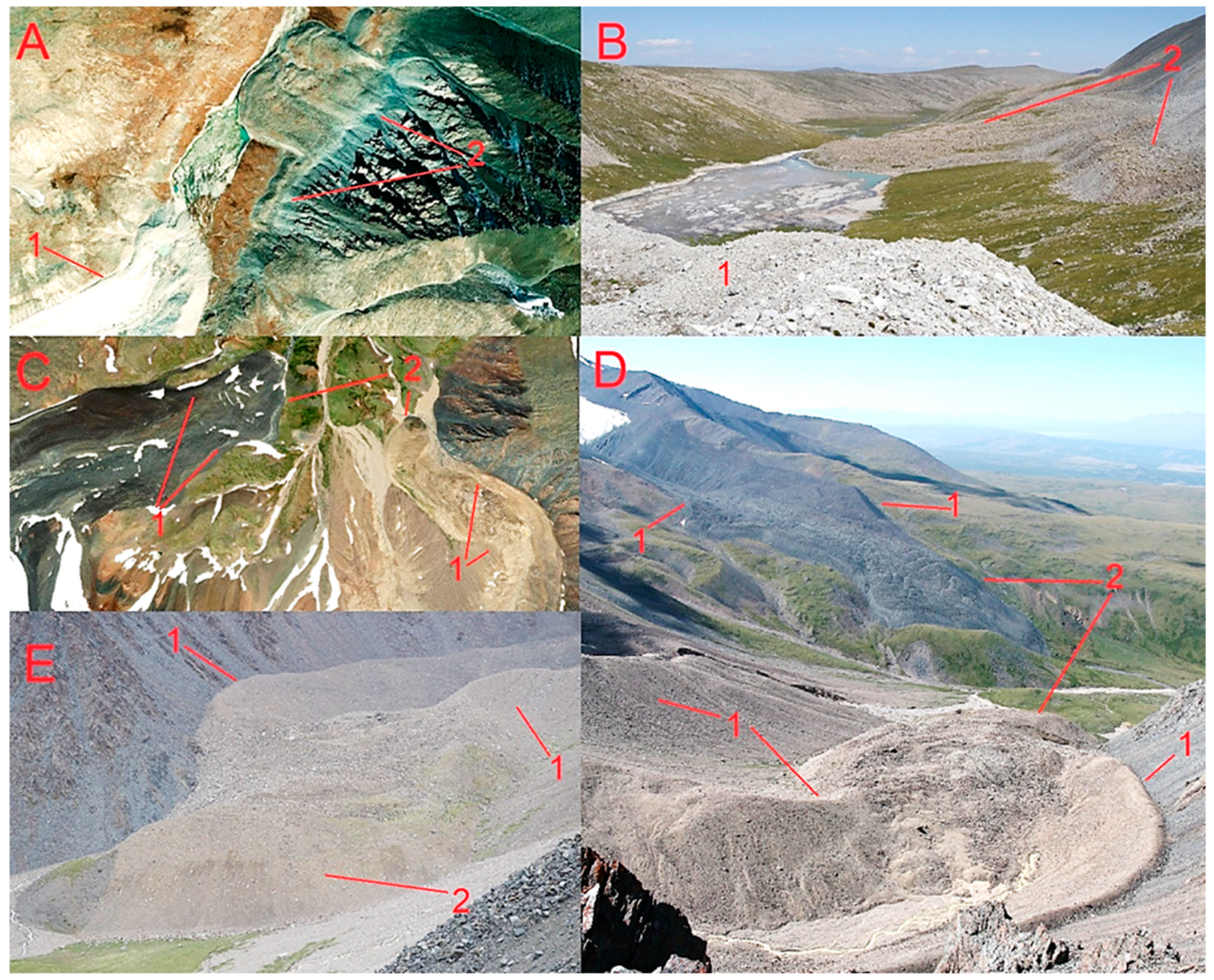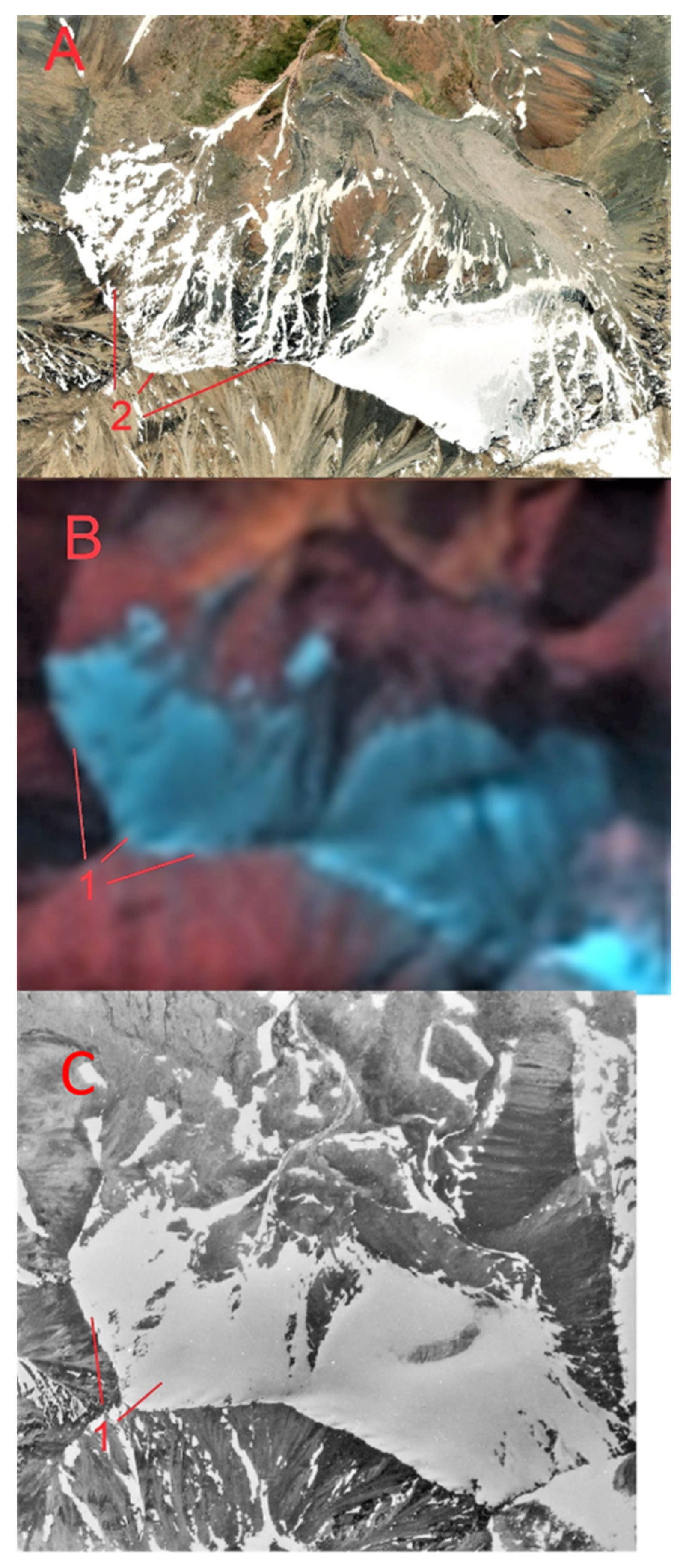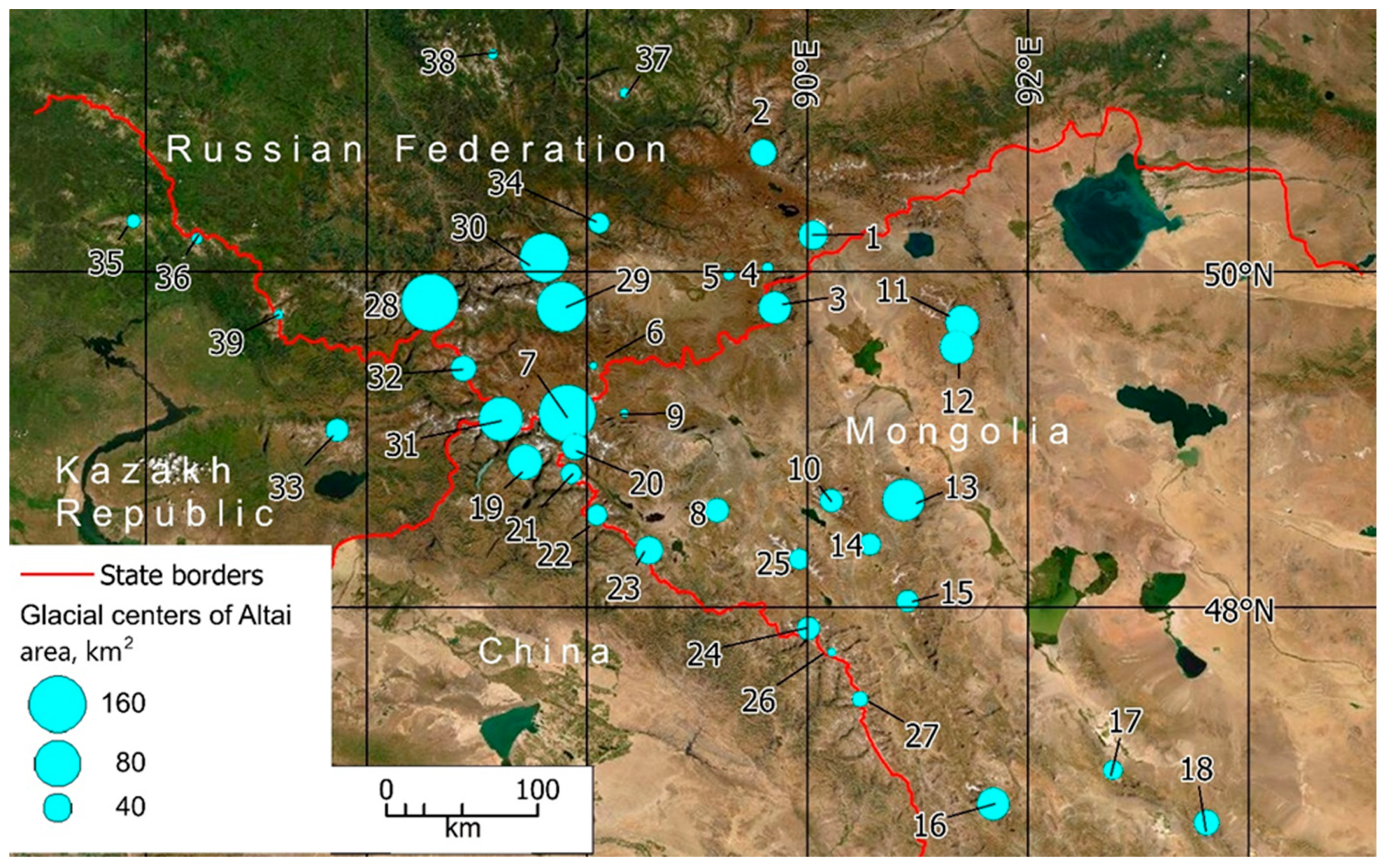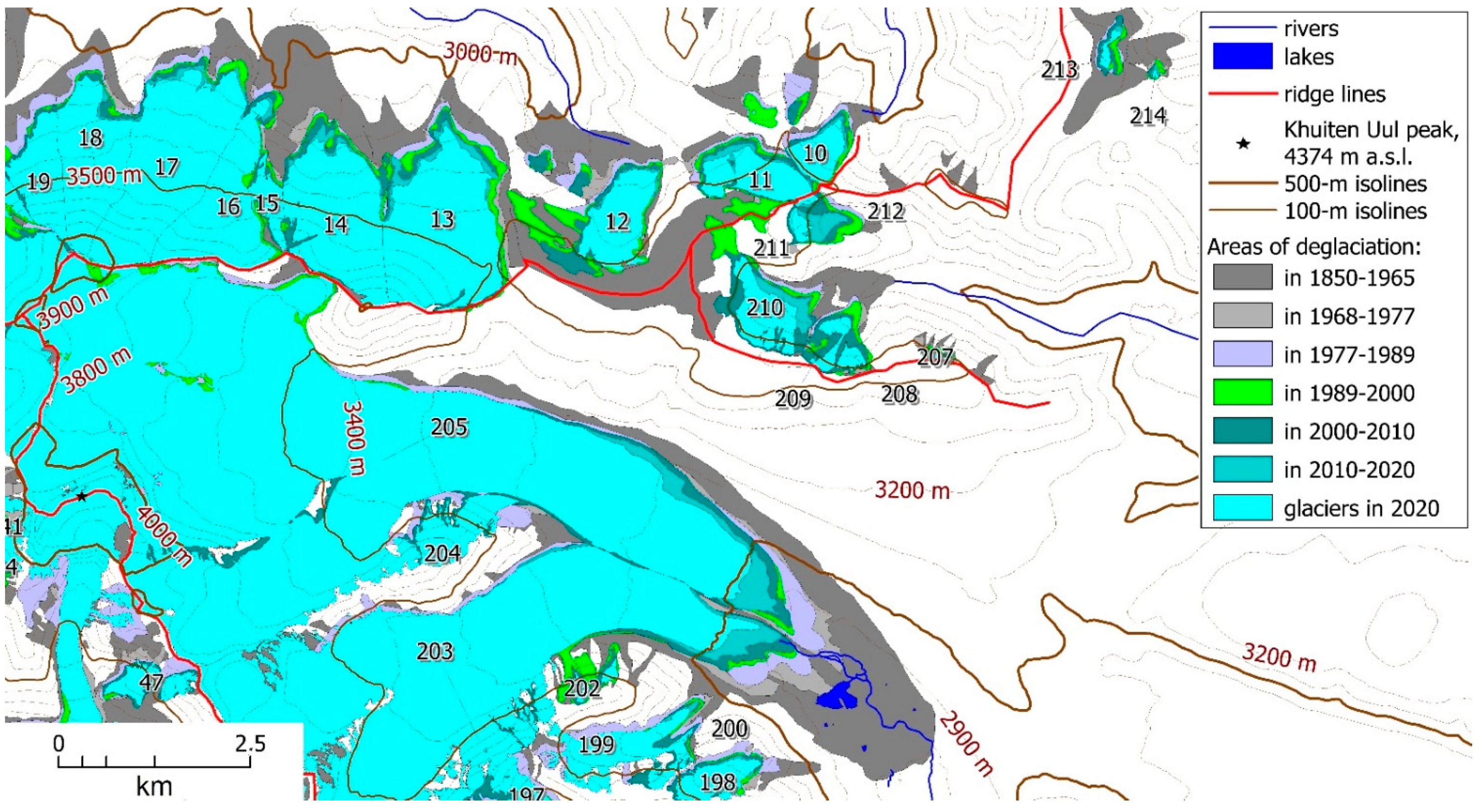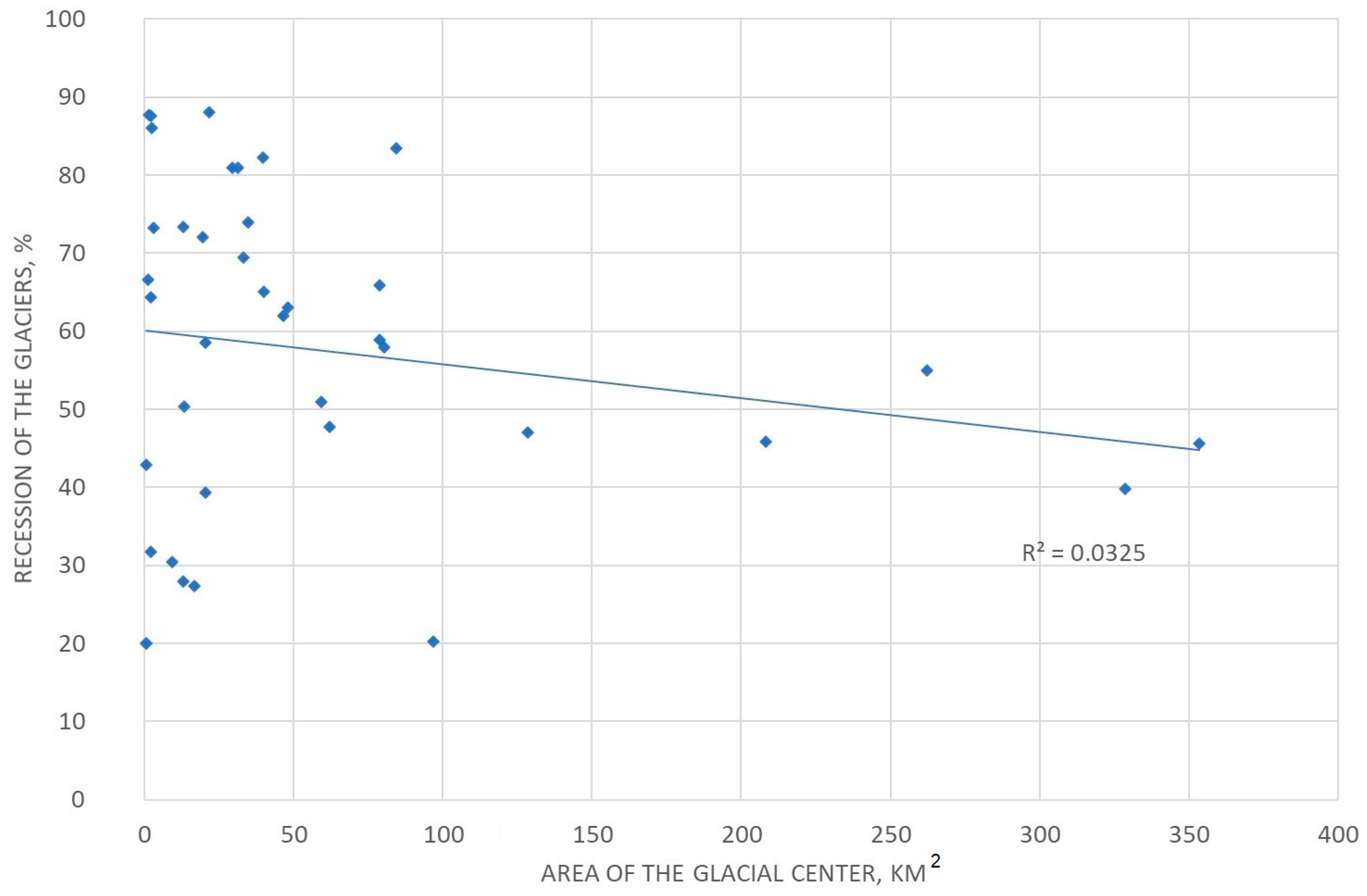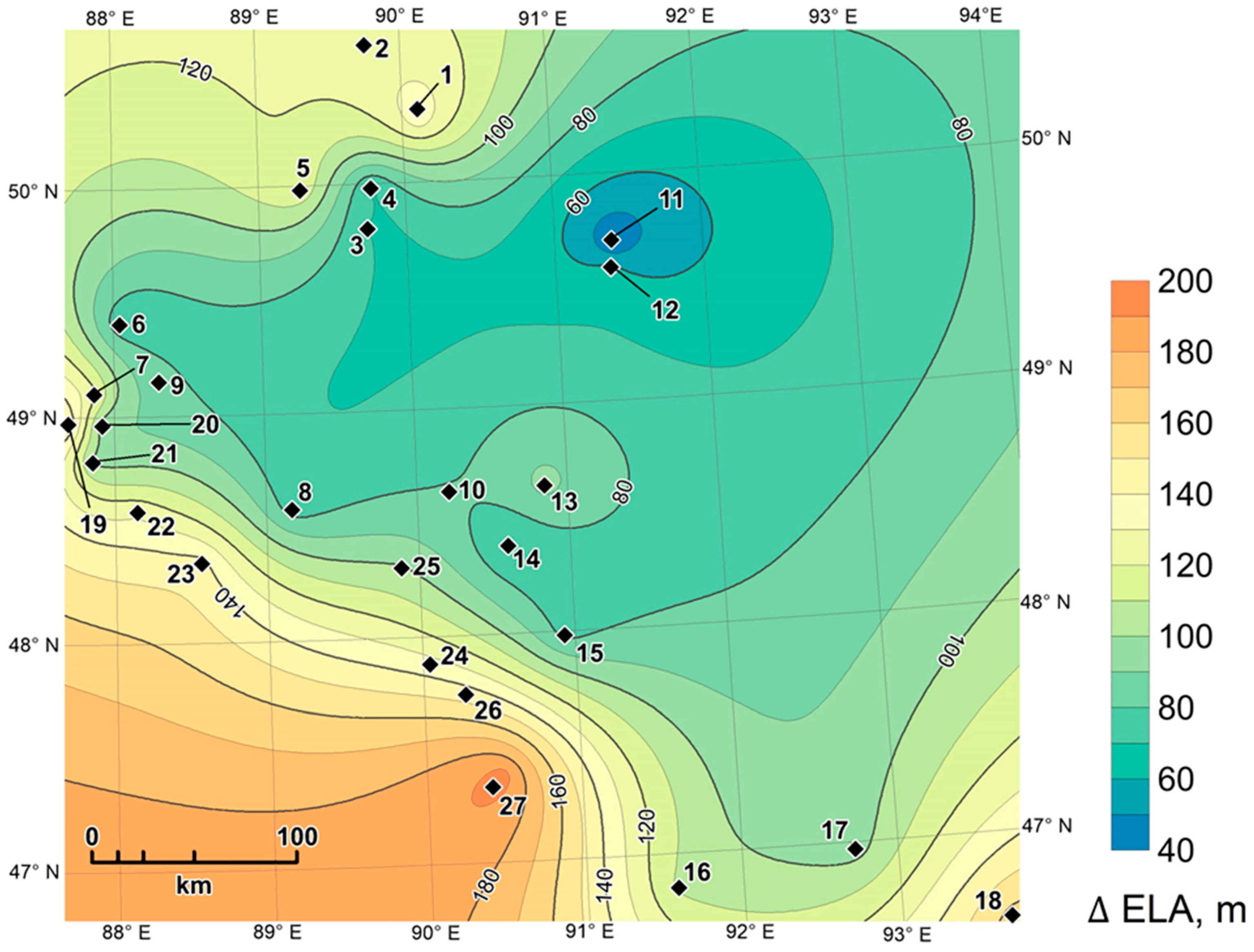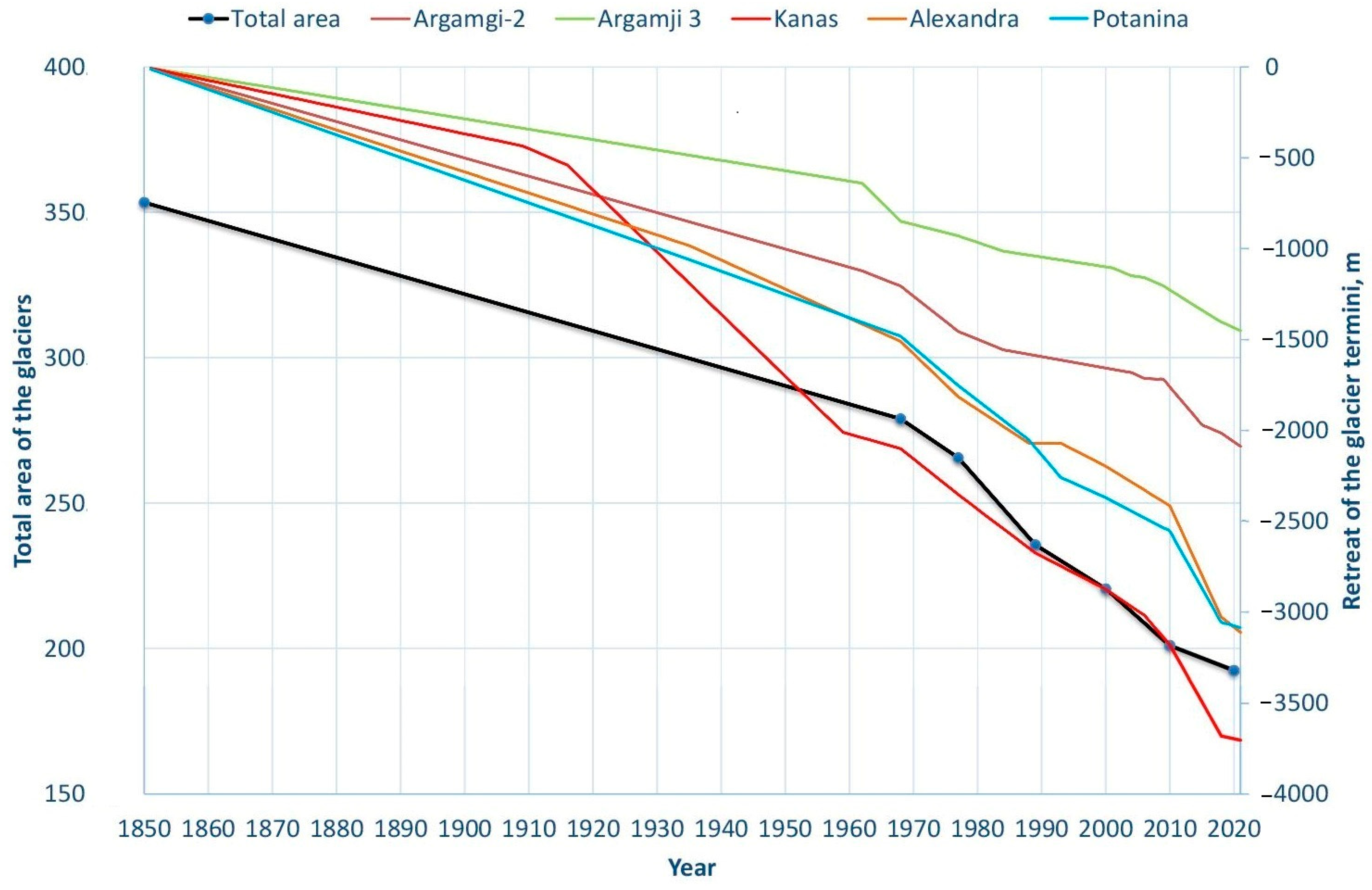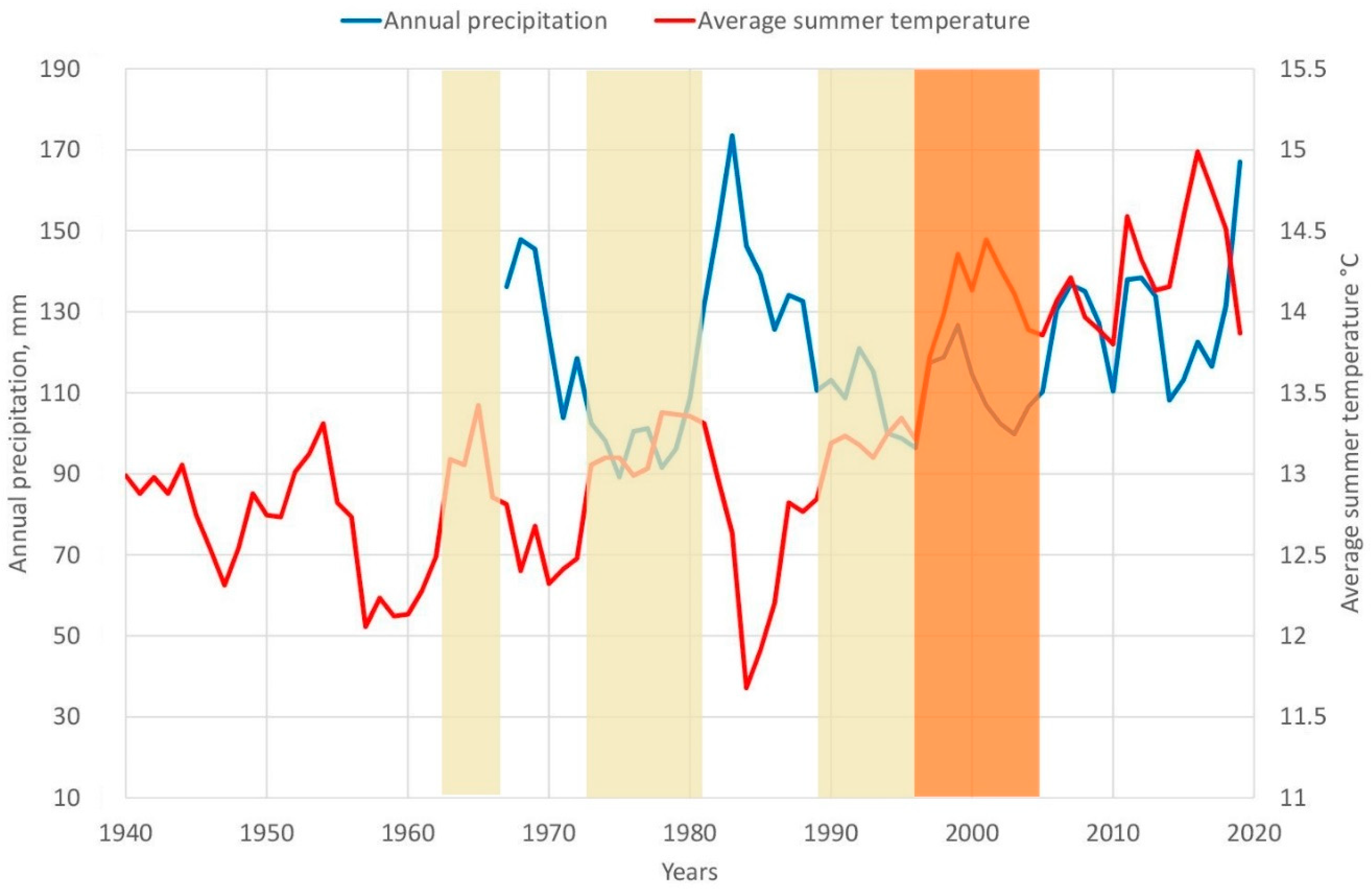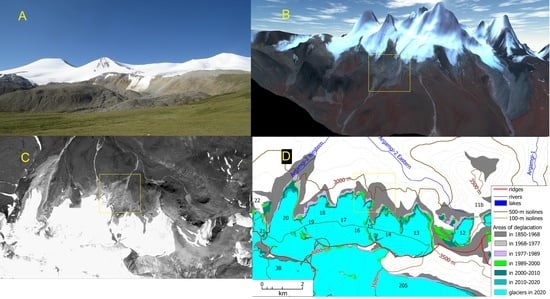Our research is based on 3 groups of methods.
2.1. Field Observations
Observations of the dynamics of glaciers relate mainly to the period of their reduction after the LIA maximum. The time of the LIA maximum in Altai was not recorded by direct observations. The first observations of the position of the edge of the glacier were made by Gebler in 1835 on the Katunsky glacier [
14]. In 1835, the glacier may still have been advancing, as indicated on the basis of geomorphological data by Okishev [
41]. According to his opinion, this advance ended in the second half of the 1830s. In 1880 when Yadrintsev visited the glacier, it had already retreated from its position in 1835 by 350–380 m, and by 1895 the edge of the glacier was 384 m away from it [
41]. Thus, at least for the Katunsky glacier, it is known that its last advance during the LIA ended in the interval 1835–1880, and most likely several years after 1835. From 1897 to 1937, the glacier retreated with an average speed of 15 m per year, with the highest rates of reduction occurring in 1935–1937 (20.7 m per year). In subsequent years, the periods of rapid shortening of the glacier length, with rates reaching 45 m per year, were separated by episodes of slower retreat of the glacier in 1937–1952, 1961–1965, 1970–1972, 1986–1989, and 1993 [
43]. In the North Chuya Range, halting of the glacier retreat occurred place in 1936, 1940, 1969, and 1993 (Right Aktru) and in 1911, 1936, 1960, 1966, 1979, and 1993 (Malyi Aktru) [
44]. There are several larger glaciers in Altai, the dynamics of which is more or less known for at least the first half of the 20th century.
The first observations of the glaciers of Altai by the geographers of Saint Petersburg State University (our research group) started in 1965 (Mongun-Taiga mountain massif) [
45]. Since late 1980s the continuous monitoring of the glaciers of Altai mountains has been established in a regime of part-time observation stations (hydrological, glaciological, meteorological, geomorphological, and dendrochronological in situ observations were made in the ablation periods). The observations were focused on the glaciers of the Mongun-Taiga massif and of the northern slope of the Tavan Bogd massif. In the last 10 years, we started observations in other glaciated areas: Ikh Turgen, Tsambagarav, Tsengel-Khairkhan, Shapshalsky ridge, South Altai ridge [
46].
Glaciological observations included monitoring of the positions of the glacial edges, locating the ELA, mass balance observations, and mass balance index calculations. Monitoring of the positions of the glacial edges is based on survey activities, such as geodetic surveying, GPS tracking of the glacial edges, measurements of the changes of the glacial length (repeated measurements of the distance between the benchmarks and the glacial edges), the usage of repeated photographs, and remote sensing. The results of this monitoring provide the opportunity to estimate the rates of advance and retreat of the glaciers. The monitoring of the positions of the glacial edges was done for different types of glaciers, but preference was given to the larger valley glaciers, which are the most representative glaciers (due to less dependence on geomorphic factors) with the longest observation periods (being at the same time easier to reach due to the lower positions of the snouts).
2.2. Remote Sensing
The remote sensing study gives the opportunity to get the information on the present state of the glaciers, to reconstruct the positions of the glaciers in the maximum of the LIA, and to fill the gaps between the time points of the field observations. Accordingly, there were 2 groups of satellite imagery: images used for the delineation of the glaciers of the Tavan Bogd massif for the different time points in the past (
Table 1) and images, used for recent glacier identification for different glaciated areas (
Table 2). The choice of time points for the imagery was, in many respects, due to the availability of the required satellite images. In addition, the images had several requirements: They should correspond to the end of the ablation season, when the elevation of the snow line is maximal, and the snow cover does not interfere with delineation of the boundaries of glaciers; it is desirable that images have low cloud cover; and images should not be taken after snowfalls. If in an individual image clouds covered parts of the glacierized area, another image from the nearest available date was collected.
The imagery of the first group (
Table 1) is represented mainly by the Landsat images provided by the USGS [
47] and CORONA images. Spot 5 images were provided by RDC ScanEx [
48] and processed by the Space and Geoinformation Technologies Resource Center of Saint Petersburg State University. For Landsat, one common false-color composite (FCC) image combination is provided by TM bands 5, 4, 3, which help delineate clean glacier ice/snow and vegetation (Paul et al. 2004, Bolch and Kamp 2006). For Landsat 7 images we used false-color composites (FCCs) that show the differences in reflectance of landscape features. In particular, we used a Landsat ETM+ and TM 5, 4, 3 RGB composite (red: channel 5; green: channel 4; blue: channel 3), the resulting effect is that snow and ice are clearly differentiated from clouds, debris, rock, or vegetation due to FCC image color differences [
49]. Furthermore, Landsat 7 images taken by the ETM+ sensor included a panchromatic band 8, which was used for pan-sharpening to improve image resolution from 30 × 30 to 15 × 15 m employing ESRI ArcGIS 10.4. We also used Landsat 2 MSS 765 and 654 RGB composite.
The second group (
Table 2) is represented mostly by Sentinel-2 imagery with 10 m maximal spatial resolution. We used a natural color band combination (B04-B03-B02). This combination allows us to not only determine the spatial position of glacier and seasonal snow, but to also delineate rock glaciers, moraines, to determine the degree of their overgrowth with vegetation. In some cases, the LIA and recent glaciers area determination had been done before the Sentinel 2 imagery became available. This is why we used Spot 4 imagery for Hunguyn-Nuru, Turgen, Kharkhiraa, and Sair (10 m resolution). In addition, for some areas we managed to get imagery of resolution, higher than Sentinel 2: Spot 5 imagery (2.5 m resolution) for Ikh Turgen, Mongun-Taiga Minor, Tsengel Khairkhan; Spot 6 for Shapshalsky ridge (1.5 m resolution); Geoeye-1 imagery for Talduair massif, Saylugem and Tsambagarav ridges (spatial resolution: 0.5 m panchromatic and 1.8 multispectral), and WorldView-2 for Mogun-Taiga massif (spatial resolution: 0.5 m panchromatic and 1.8 multispectral).
The delineation of the recent glaciers and of the geomorphological forms marking their positions in the maximum of the LIA has been done manually. The minimum size of the glaciers to be mapped was 0.01 km2.
The systematic error was defined as ±1 pixel (0.5 m for Geoeye-1 and WorldView-2, 1.8 m for Corona, 2.5 m for SPOT 5, 10 m for Sentinel 2, 15 m for Landsat 7, 30 m for Landsat 4 and 60 m for Landsat 2). Thus, the error of area determination is calculated by a simple formula:
where
n is the number of pixels defining the perimeter of the glacier area, and
m is the spatial resolution of the sensor bands applied expressed as an area of the pixel.
The percentage error of area determinations,
Arer, is given by:
where
Agl—the area of the glacier.
The total systematic error was 5.6%.
To assess the subjective “cartographer’s error”, we took a sample of 100 glaciers. Within the sample, the distribution of glaciers by area corresponded to the distribution by area of glaciers within the entire data set. Sample glaciers were remapped. The error was determined by comparison of remapping results with the glacier areas obtained in the course of cataloging. The average error for the entire sample was 6.0%.
The main mistakes in determining the glacier limits of the glacier are associated with several factors:
Debris-covered glacier edges or the areas of dead ice under the moraine cover adjacent to the glaciers that merge in color with the end moraines of the LIA complex, which is typical for the region. Thus, both underestimation and overestimation of the size of the glacier is possible. For such cases, we use indicators defined by Loibl et al. [
36]: active ice indicators are the “smooth” debris surface, linear flow structures, and constrained tributaries; dead ice indicators are the rugged debris surface, melting ponds, unconstrained tributaries, and pioneer plants. We added two more diagnostic signs: for the massifs of dead ice it is typical when the water flows into tunnels and its exits from other tunnels down the slope; the active glacial edge is marked by marginal flows that join at the lowest point of the glacier [
50]. All these indicators work well, with the exception of pioneer plants, which, due to the dry climate of the central and eastern parts of Altai, are absent near the glaciers in those areas and appear only on the surface of inactive rock glaciers. We also tried to use the results of in situ observations whenever possible, which helped to solve this problem in some complicated cases (
Figure 2);
Another typical problem is the overestimation of the glacial area after snowfalls or when the seasonal snow cover has not melted. This problem is solved by the selection of satellite images at the end of the season. In some cases, for example, when the snow cover persists for a long time in the areas of dead ice, to control the interpretation, it is necessary to use images of other months or even years, or, if possible, the results of ground observations (
Figure 2E,F and
Figure 3);
Perennial snow patches and small glaciers are very similar; mistaking snow patches for glaciers can lead to an overestimation of the glacier area. We were guided by the following distinctive features: glaciers have an integral configuration, while snowfields often have openwork outlines in plan; for glaciers, the images show ablation and accumulation zones; as a rule, crevasses or bergschrunds are visible on the surface of glaciers, which are indicators of glacier movement;
The shading of some parts of the glacier and the adjacent non-glacial areas, that usually leads to underestimation of the glacier area. This problem can be solved if the images of the same area with different acquisition times and different angles of sunlight are compared;
Medial moraines on the surface of glaciers can often be mistaken for rocky outcrops that separate glacial streams. As a rule, in addition to the characteristic position at the contact of the adjacent glacial streams, the medial moraines acquire a convex shape as the surfaces of open ice decrease during the degradation of glaciers. As a result, in some areas the moraine cover crumbles and the ice core of the moraine is exposed, which helps to correctly diagnose it. Such formations should not be excluded from the total area of glaciers, since they move with them, until they lose contact with open areas of the glacier and become independent formations;
Frozen glacial lakes can be mistaken for parts of a glacial tongue, leading to an overestimation of the glacier area. In this case, if it is not possible to find images for the period when the ice on the lake has already molten, it is possible to use digital elevation models, in which this area will look such as an absolutely flat territory, contrasting with the sloped areas of the glacial tongue.
We used a 30-m SRTM 1 Arc-Second Global DEM [
51] to characterize our glacier outlines with parameters including mean, minimum, and maximum elevation ranges, and mean slope and aspect.
Those parameters were determined automatically based on the DEM in the Global Mapper v.18.0 software (digitizer tool). Field data were used to verify the data obtained from remote sensing sources.
Since ELA cannot always be detected on satellite images, especially for small glaciers, for the consistency of the obtained data on ELA, we used the Kurowski method [
52,
53] for its identification. In this method, the firn line altitude or ELA is calculated as the average altitude of the glacier:
where
is the firn line altitude or ELA,
are the areas of the different altitudinal zones of the glacier,
are the average altitudes of these zones, and
.
The Kurowski method is based on the assumptions that ablation and accumulation on a glacier change linearly with altitude and that the glacier is stationary. The assumption of linearity of changes in ablation with changes in altitude introduces a systematic error associated with the concave nature of the real curve of ablation versus altitude, due to which the ELA lies below the weighted average glacier elevation. At the same time, errors due to the assumption of linearity of changes in ablation with altitude and due to the assumption of glacier stationarity have the same signal during the period of glacier advance and opposite during the period of its retreat, that is, in the second case, they compensate each other, increasing the accuracy of the results. This exactly corresponds to the situation of our study, when glaciers are considered to be in the phase of intense retreat.
Thereby, the Kurowski method has high accuracy in relation to the recent glaciers of Altai was also used to verify the values of ELA, found by remote sensing.
According to recent studies by Braithwaite [
54], who tested the method for the 103 glaciers of different morphology and from different regions of the world, there is a high correlation between balanced-budget ELA and Kurowski mean altitude, with a small mean difference of −36 m between the two altitudes with standard deviation ±56 m. Balanced-budget ELA is significantly lower (at 95 confidence level) than Kurowski mean altitude for outlet and valley glaciers, and not significantly lower for mountain glaciers [
54].
In our work on the current state of the glaciers of the Shapshalsky Center [
55], calculations using this method for 26 glaciers (cirque and hanging glaciers with areas less than 0.6 km
2) gave results close to the ELA position obtained by remote sensing (the average value of the difference was −8 m) (
Table 2). We also considered the results of determining the position of the ELA by the Kurowski method from the standpoint of the possible application of the AAR method, which is currently widely used. The AAR assumes the accumulation area occupies a fixed proportion of the total glacier area. The average AAR, obtained from a global dataset of 99 glaciers is 49.2% or 0.492 Durgerov [
56]. For the high Asia region the AAR is 0.51 (which is partly due to the area of the Karakoram anomaly-—the area of mass gain of the glaciers and high AAR, caused by it) [
57]. For Tien Shan mountains, which are the closest to Altai range both geographically and climatically the average AAR is 0.43. Unfortunately, no regional average AAR value for Altai is available yet, but results our studies, shown in
Table 2 and
Table 3, allow us to assume values of about 0.44, which differs little from the average values obtained by the Kurowski method (0.48). This confirms the validity of the latter.
The Kurowski method was also tested by us for the glaciers of the Tavan Bogd massif in the area range of 3.3–23.1 km
2 (
Table 3). In this case, the calculated values of the ELA by the Kurowski method as of 4 points in time and the data obtained from the corresponding satellite images were considered. It should be taken into account that the comparison was made not with the balanced-budget ELA, but with its values obtained from the images (the latter gives only some approximation to its actual position, corresponding to the moment of the greatest rise in the seasonal snow line, images fixing this moment are not always available). Therefore, the difference between the calculated values and balanced-budget ELA could be less than our average value of 77 m. Taking into account the vertical span of the studied glaciers, which reached about 1.5 km, such an error can be considered acceptable.
Designations are given in
Table 2. Numbers of the glaciers correspond to the catalogue from [
50].
There is an idea that the ELA concept is not applicable to all glaciers. This idea was stated by Braithwaite: “… For example, on glaciers with a small altitude range, local variations in specific balance may mask the altitudinal variations so there is no simple line separating the ablation area from the accumulation area. In an extreme case, where the specific balance values are more or less randomly distributed over the glacier surface, the ELA concept is meaningless, and the balanced-budget AAR will be about 0.5” (p. 128) [
58]. A similar situation occurs for a significant number of small glaciers in the study area, especially in arid regions, where the redistribution of snow by wind at low altitude mass balance gradients plays a decisive role in the configuration of the feeding zone, significantly obscuring the effect of height. Nevertheless, the very fact of the existence of glaciers at these heights indicates sufficient climatic conditions for this; accordingly, it makes sense to determine the climatically determined lower boundary of the zone of glacier development. From this point of view, the definition of ELA makes sense, and the use of the Kurowski method makes it possible to smooth out random fluctuations in the position of this boundary caused by orographic conditions.
An important advantage of the Kurowski method is its ease of use, which is especially beneficial when working with a large number of glaciers.
2.3. Paleo Reconstructions
Reconstruction of the LIA extent of glaciers was done on the basis of geomorphological methods. LIA moraines were mapped using satellite imagery, aerial photos, tachometry, GPS tracking of the lateral and terminal moraines, and visual in situ observations. We used the method of ground-based route interpretation that included descriptions, measurements and photography in reference areas. For object recognition, we used the visual interpretation method according to reference standards [
59,
60]. The reference standards were compiled from ground-based observations, indicating the following characteristics: characteristic images of objects on the terrain, in the aerial photograph, in the satellite image and in the topographic map; distinctive characteristics of objects; and methods of transferring objects to the map. The criteria which we used to identify moraines using the satellite imagery and DEM are largely similar to those suggested in [
61]: “identification criteria include shadowing due to changes in topography (relative relief) and changes in color due to changes in soil, soil moisture, and vegetation cover. Associated landforms such as deflected abandoned meltwater channels are also useful in delineating the break-of-slope of these features”.
Furthermore, we used high-resolution images and compared interpretation results with in situ field observations. For Mongun-Taiga mountain range, we created interpretation standards [
62], which we used first for Tavan Bogd massif [
50] and subsequently in all other areas studied. A characteristic property of the study area favorable for visual interpretation includes the persistence of glacial topographic characteristics associated with climate aridity, low erosion rates, low rates of biological processes, and poor development of periglacial vegetation cover. Low temperatures, high intensity of frost weathering and small precipitation amounts promote a long-lasting preservation of buried glacier ice. All of this causes sharpness of most glacial landforms in aerial photographs and satellite images whose interpretation is made easier by the almost total absence of forest vegetation. Diagnostic features of LIA moraines are their bareness, steep fronts and relatively large thickness, glacial ice cores that are sometimes exposed by thermokarst processes, and position adjacent to modern glaciers. The low degree of vegetation cover of LIA moraines in multispectral images is expressed by a gray or brown color of moraines in sharp contrast with greenish color of the surrounding subalpine meadows and tundra and the moraines of earlier glacier advances (
Figure 3), so they are easily identified. This is particularly characteristic for the LIA moraines which usually merge or overlap the more ancient late Holocene moraines of the stage that is called “historical stage” in Altai [
63]. The third characteristic feature is the presence of the ice core of glacial origin. Beginning in the late 1990s, an intensification of thermokarst processes in the LIA moraines has given rise to numerous thermokarst depressions, thermoerosional forms, and landslides [
9], which stand out in steep areas of dumped moraines in the form of sharp and contrasting dark bands visible in images with a resolution better than 15 m.
When delineating LIA moraines, a serious problem is their similarity to rock glaciers, which often leads to an overestimation of the glacier area. In the case of talus rock glaciers [
64], the problem of their differentiation from moraines is solved quite simply: they are located below talus slopes devoid of the glacial exaration forms such as cirques or corries (
Figure 4A,B: 2). On the contrary, debris rock glaciers develop below the LIA moraines or overlap them and move further down the valley (
Figure 4C–E: 2). In such cases the reconstructed LIA glacier fronts we placed between the lowest points along the valleys, where the lateral moraines are diagnosed (
Figure 4C–E: 1).
Reconstruction of the glaciers of the LIA maximum was carried out not only on the basis of moraine mapping. We used the clear boundaries between unweathered freshly glacially eroded areas and weathered, vegetated areas, in particular fresh glacial erosion marks on the walls of the cirques and troughs in the upper parts of the valleys, corresponding to the LIA moraines located further below the valley.
Much attention was paid to hanging glaciers, traditionally underestimated in paleo reconstructions, which do not form moraines. Diagnostics of such glaciers were carried out on nival niches with sharp outlines, indicating the recent degradation of the glaciers that formed them. As a rule, such niches are marked with modern snow patches. For some of these glaciers, the degradation process has occurred recently and was detected by our field observations and satellite and aerial photographs (
Figure 5), making it possible to use the nival niches that remained in their place as interpretation standards.
There is no unambiguity in the estimates of the time of the culmination of the LIA glaciers and the formation of the corresponding moraine in Altai. According to some authors [
65], the time of the greatest advance of glaciers corresponded to the 17th century, but most researchers believe that the greatest advance of glaciers belongs to the beginning [
66] or to the middle of the 19th century [
25,
59,
67]. The time of the LIA maximum in Altai was not recorded by direct observations. Okishev [
41], on the basis of a study of many glaciers of the Russian Altai, came to the conclusion that the last stadial glacial cycle for each of the glaciers developed with some differences from others, i.e., there was no complete similarity in the details of the process. Another important conclusion: the universality of the stage of the 17th–19th centuries. and a two-fold glacial advance of equal scale. The latter means, on average, approximately the same size of glaciers during periods of movement in the early 17th and mid-19th centuries.
We do not have direct dating of the glacial advances of the LIA, but there are several results of
14C dating from Mongun-Taiga massif, characterizing the preceding warm period in the area of research: peat buried by debris cone (East Mugur valley) at altitude 2535 m (1190 ± 60
14C, 1130 ± 80 cal BP, (LU-6817)), soil buried by LIA moraine at altitude 2630 m (Right Mugur valley) (1280 ± 80
14C, 1200 ± 90 cal BP), (LU-6818) [
25]. In our previous work, to reveal the time of the maximal glacial advance of the LIA we used the summer temperature and annual precipitation data obtained by dendrology to calculate mass balance changes for the level 3300 m (the firn line of the reconstructed LIA glaciers of Mongun-Taiga massif) [
25]. According to the calculated mass balance curve, the period of climate, favorable to glaciers finished about 1790–1800, which was taken as the end of the “climatic” LIA, the intervals of subsequent strongly negative mass balance occurred around 1815, 1850, 1890 [
25],
Figure 5, the start of the glacial retreat was estimated by 1810–1820. However, this assumption was not supported by the estimations of the time of reaction of the termini positions to a climate change. Later we did such estimation for the fronts of four valley glaciers of Mongun-Taiga and the northern slope of Tavan Bogd on climatic fluctuations is estimated between 11 and 20 years, however, taking into account larger areas and higher thickness of the LIA glaciers that lag between the start of the period of negative mass balance and the start of the retreat of the glacier fronts could be longer. Moreover, the glaciers of Mongun-Taiga and north slope of Tavan Bogd massifs are relatively small, for larger glaciers exceeding the area of 5 km
2 that period could be additionally longer. This is partly confirmed by the only known mid-19th century observation of the Altai glaciers, according to which the Katunsky glacier was still advancing in 1835 and started its retreat between 1835 and 1880 [
14]. In 1835 the glacier may still be advancing, as indicated on the basis of geomorphological data by Okishev [
41]. Thus, we cannot take the years before 1835 as the starting point for the general retreat of the Altai glaciers. In this case, the next minimum of the mass balance of glaciers around 1850 could become the starting point for the general retreat of the Altai glaciers, which we tentatively accepted in this article.
